
Vegetables in Sailor's Accounts Menu: 1 2 3 4 Next>>
Vegetables in Sailors Accounts During the Golden Age of Piracy, Page 3
Vegetables Found In Sailor's Accounts, Continued
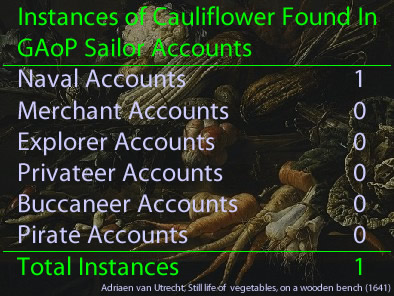
Cauliflower
(Brassica oleracea)
Called by Sailors: Colly Flowers
Vegetable Type: Other (Cruciferous)
Appearance: 1 Time, in 1 Unique Ship Journey from 1 Sailor Account.1
Locations Found in Sailor's Accounts: Malta;
Cauliflower is only found in one account, that of navy clergyman Henry Teonge. Teonge said the when HMS Assistance stopped at Malta, they were able to purchase "excellent colly flowers, and large on[e]s for 2d. a peice."2 Note Teonge's apparent excitement at the price for cauliflower. "Cauliflower was considered a bit of an extravagance in the 16th, 17th and 18th centuries... Many authors of the time period list it as one of the delicacies found in the gardens of gentlemen. Its elite status was due to the difficulty of raising cauliflower."3 Cauliflower is unlikely to have been included in the diet of the average navy sailor, however. Teonge ate with the officers of the ship, whose food was typically much more diverse and exclusive than that of the regular sailor.
The word 'cauliflower' comes from the Italian word cavolfiora, which literally means "cabbage flower". Herbalists John Parkinson, John Gerard and author/gardener John Evelyn all include
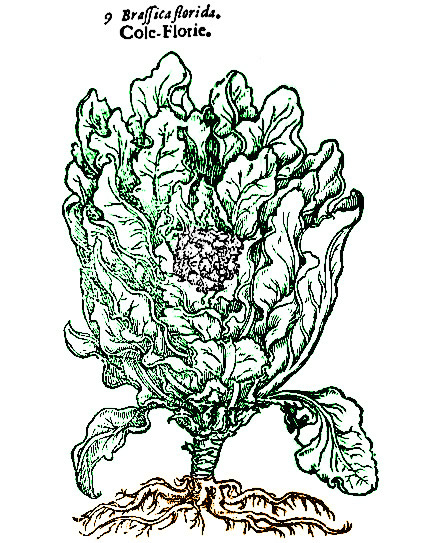
'Cole-Florie', From The Herball or General Historie of Plantes, By John Gerard (1636)
it in their entries for cabbages.3 In this, they are correct as it is indeed the same species as cabbage and colewort, Brassica oleracea. Other cultivars in this species include broccoli, Brussels sprouts, collard greens, kale and kohlrabi.
Parkinson's description is most thorough:
The Cole flower is a kinde of Coleworte, whose leaves are large, and like the Cabbage leaves, but somewhat smaller, and endented about the edges, in the middle wherof, sometimes in the beginning of Autumne, and sometimes much sooner, there appeareth a hard head of whitish yellow tufts of flowers, closely thrust together, but never open, nor spreading much with us, which then is fittest to be used, the green leaves being cut away close to the head4
As food, Evelyn considers cauliflower one of the best types of cabbages, although he suggests that only the Dutch eat them and other Brassica oleracea species raw. He suggests that "the white, large and ponderous are to be chosen; and so the Cauly-flower: After boiling some steep them in Milk, and seethe them again in Beef-Broth"5. Parkinson says that cauliflowers have "a much pleasanter taste then eyther the
Coleworte, or Cabbage of any kinde, and is therefore of the more regard and respect
at good mens tables."6
None of the period authors discuss the humoral or medicinal aspects of cauliflowers separately, indicating that they would share these properties with cabbages.
1,2 Henry Teonge, The Diary of Hentry Teonge, 1825, p. 133; 3 Barbara Rust Brown, "A Classy Cabbage", /www.colonialwilliamsburg.org, gathered 10/27/22; 4 John Evelyn, Acetaria, or a Discourse of Sallets, 1699, p. 15; John Gerard, The Herball or General Historie of Plantes, 2nd ed, 1636, p. 314; John Parkinson, Paradisi in Sole, Paradisus Terrestris, Reprinted from the Edition of 1629, 1904, p. 504; 5 Parkinson, p. 504; 6 Evelyn, p. 16; 7 Parkinson, p. 504
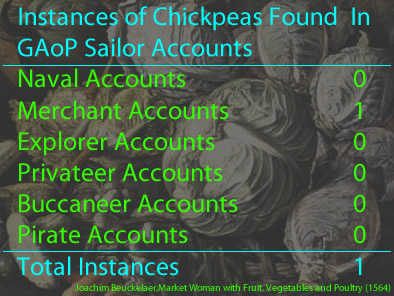
Chickpeas (Garbanzo Beans)
(Cicer arietinum)
Called by Sailors: Gram
Vegetable Type: Legume
Appearance: 1 Time, in 1 Unique Ship Journey from 1 Sailor Account.1
Locations Found in Sailor's Accounts: Bengal, India;
Chickpeas appear twice in the sailor's accounts under study. "In 1701 the Upton Galley was in Bengal where weekly rations were rice, oil, ghee [clarified butter], 'gram' (chick-peas), fresh bread, arrack, beef and large numbers of hogs kept on board in bamboo sties and tended by 'pariars' (ie untouchables) hired for the purpose."2 While Earle identifies 'gram' as chick-peas, it often refers to chick-pea flour, which would presumably be used to make savory puddings, regular fare on navy and merchant voyages. In his account of the East Indies from the period, Captain Alexander Hamilton mentions that Balasore, India "is fruitful to Admiration, producing Wheat, Gram, Doll Calavances [dhal calavances- lentils], several Sorts of Pulse..."3, although he doesn't go so far as to say they were eaten by sailors.
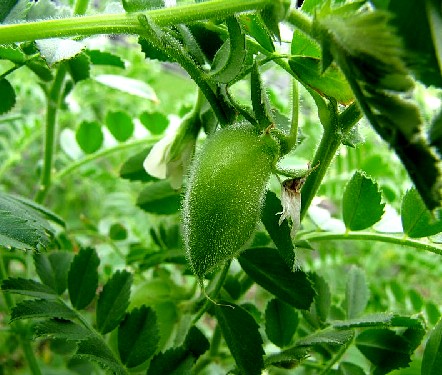
Photo: Forest and Kim Starr - Chickpea (Cicer Arietinum) Seedpods, Maui
As explained in the entry on beans, the term 'calavance' was a rather generic description of a bean and it is possible that some instances of calavances found in the sailor's accounts might refer to chickpeas, particularly when a ship was in the Mediterranean or East Indies. However, since calls them 'Doll' Calavances he is referring to lentils. It is his use of the word 'Gram' which refers to chickpeas.
Chickpeas are sometimes lumped in with regular peas and frequently referred to as ciches in the herbalists' books. Ciche comes from the Latin word for them: cicer; in one instance botanist John Gerard refers to them as "Ciche-pease"4. John Parkinson divides them into wild and garden ciches, specifying three types of garden ciche - white, black and red - and five types of wild ciche - 'greater, woolly mountaine, mountaine without stalke, mountaine and three leafed'.5 He describes the garden chickpea being "contained in small thicke and short pods, wherein lie one or two Pease more usually, a little pointed at the lower end, and almost round at the head, yet a little cornered or sharpe"6. French botanist Louis Lémery identifies four types of 'Chick-pease', "white or red, black, or purple, and ...are in shape almost like the head of a Ram.... They are contained in small Cods like Bladders"7.
As food, Parkinson notes that Galen indicated that chickpeas "are no lesse windy meate [food] than Beanes, but yet nourish more".8 French botanist Louis Lémery suggests they "have the same taste as your common Pease... and not much used for Food, but more in Physick [medicine]. The red ones are esteemed before the others."9 Parkinson mildly disagrees, explaining in
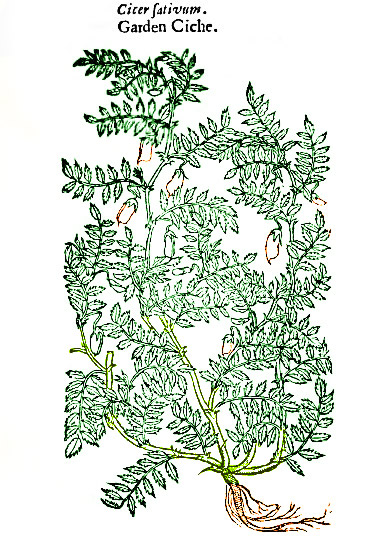
Chickpea Plant 'Cicer Sativum', From The Herball or General Historie of Plantes,
By
John Gerard (1636)
one of his books that "the white [chickpea] is onely used for meate [food]", while the others are used in medicine.10 However, in his other botanical book he indicates that while all the wild chickpeas are for medicinal use, the 'garden' chickpeas can also serve in this capacity. Parkinson also notes that the Spanish have chickpeas called 'Grauancos, and Garauancillos', which likely refers to the Spanish word for them - garbanzo. He explains that the Spanish "eate them boyled and stewed as the most dainty kinde of Pease that are, they are of a very good rellish, and doe nourish much; but yet are not without that windy quality that all sorts of Pulse are subject unto"11.
None of the Galenists indicate the humoral properties of chickpeas, although Gerard mentions that both they and peas have the same properties as beans12 which are hot and moist in the first degree. Similarly, Lémery doesn't mention the Paracelsian principals associated specifically with chickpeas, but he includes them in a remark in his entry on peas, so they would have the same principles - much oil, salt and Phlegm.
Medicinally, Lémery says, "Chick-pease provoke Urine, Women's Terms, and allay the sharp humours of the Breast;; they make use of them by way of decoction for the Stone and Cholick in the Reins [kidneys]."13 Expanding upon that last idea, Gerard explains that "Ciches do scoure more than doe the true Beanes: insomuch as certaine of them doe manifestly diminish or waste away the stones in the Kidneyes."14 Citing Greek physician Pedanius Dioscorides, Parkinson says that when combined with rosemary, chickpeas are "good for the Dropsie, and the yellow Jaundise, and to ease the paines in the sides, for which purpose this medicine is very powerfull", however he adds that "Cicers are hurtfull to those that have ulcers in their reines or kidnies, or in the bladder."15 Parkinson also notes that wild chickpeas "are so much more powerful then those of the Garden, by how much they heate and drynesse, perceived by their sharper and more bitter tastes whereby they doe the more open obstructions,provoke urine, breake the stone and all those other properties of cutting, opening, digesting and dissolving that are attributed to the former"16. Note that he indicates here that chickpeas have hot and dry (rather than hot and moist) humoral properties.
1,2 Peter Earle, Sailors: English Merchant Seamen 1650-1775, 1998, p. 89; 3 Alexander Hamilton, A New Account of the East Indies, 1746, p. 379; 4 See John 5 John Gerard, The Herball or General Historie of Plantes, 2nd ed, 1636, p. 1026; 5 John Parkinson, Theatrum Botanicum the Theater of Plants, 1640, pp. 1075-7;6 Parkinson, Theatrum Botanicum..., p. 1076; 7 Louis Lémery, A treatise of foods in general, 1704, p. 60; 8 Parkinson, Theatrum Botanicum..., p. 1076; 9 Louis Lémery, 10 Parkinson, Paradisi in Sole, Paradisus Terrestris, Reprinted from the Edition of 1629, 1904, p. 522; 10 Parkinson, Paradisi in Sole..., p. 524; 12 Gerard,pp. 1221 & 1222; 13 Lémery, p. 60; 14 Gerard, p. 1222; 15 Parkinson, Theatrum Botanicum..., p. 1076; 16 Parkinson, Theatrum Botanicum..., p. 1078
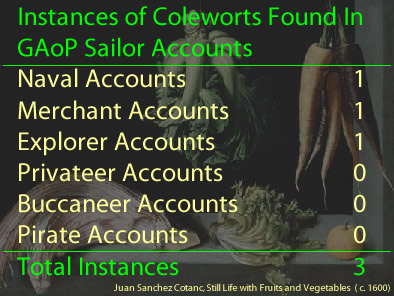
Colewort
(Brassica oleracea)
Called by Sailors: Colewort, Colwardes, Colwort
Vegetable Type: Salading
Appearance: 3 Times, in 3 Unique Ship Journeys from 3 Sailor Accounts.1
Locations Found in Sailor's Accounts: Cork, Ireland; St. Helena; Puerto San Julián, Argentina;
A colewort is another cultivar of Brassica oleracea, like cauliflower and cabbage. Coleworts are mentioned in three sailor's accounts, none of which provide any information other than the name. It is possible that the sailors under study might have been referring to cabbages when the mention coleworts, given the loose terminology of the time. However, without any other information and given their different appearances, we will assume that they knew enough to differentiate between the two.
The period botanists treated garden cabbages and coleworts as separate vegetables, another reason to give them their own section. John Parkinson draws the distinction between the two: "The Cabbidge... is of many sorts.... all these close their innermost leaves so intricate that they grow into a round head, the outermost leaves onely abiding loose and open. The Colewort
Photo: Wiki User Daderot - Colewort (Brassica oleracea), Royal Botanical Garden, Madrid
is well knowne never to close the leaves, grow alwayes spreading"2. Even so, he places both under the heading 'Colewort'. Herbalist John Gerard describes garden coleworts have "many great broad leaves of a deepe blacke greene colour, mix'd with ribs and lines of reddish and white colours: the stalke groweth out of the middest from among the leaves, branched with sundry armes bearing at the top little yellow floures"3.
In addition to the garden colewort, Parkinson explains, "There is greater diversity in the forme and colour of the leaves of this plant, then there is in any other that I know groweth upon the ground. But ...many of them being of no use with us for the table [as food], but for delight... I will here therefore shew you onely those sorts that are ordinary in most Gardens, and some that are rare". Those he identifies include:
1) Curled coleworts: "eyther wholly of a greene colour, or of divers colours in one plant, as white, yellow, red, purple or crimson, so variably mixed, the leaves being curld on the edges, like a russe band, that it is very beautifull to behold."
2) Another curled colewort: "of lesse beauty and respect, being but a little curld on the edges, whose leaves are white, edged with red, or green edged with white."
3 & 4) "Two other there are, the one of a popingaye greene colour: the other of a fine deepe greene, like unto the Savoyes [savoy cabbages]."4
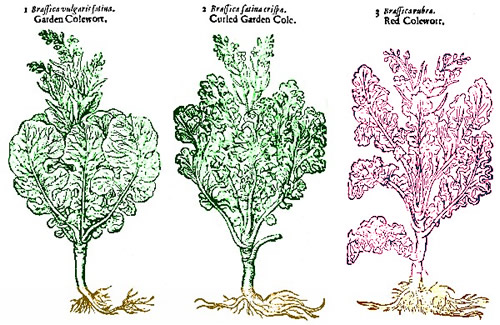
Chickpea Plant 'Cicer Sativum', From The Herball or General Historie of Plantes,
By
John Gerard (1636)
Gerard adds a "red kinde of Colewort is likewise a Colewort of the garden, and differeth from the common in the colour of his leaves, which tend unto rednesse; otherwise very like."5
When it comes to colewort preparation, Parkinson generally lumps them in with cabbages, which "are most usually boyled in poudered beefe broth until they be tender, and then eaten with much fat put among them." However, he adds that "deepe greene Colewortes, beeing boyled and layde into dishes, are served to the table with oyle and vinegar in the Lent time for very good sallets."6 Curiously, while John Evelyn talks about cabbages in his book on salads, he doesn't mention coleworts.
Humorally and medicinally, coleworts were said to have the same properties as cabbage. Gerard explains, "The whole substance or body of the Colewort is of a binding and drying faculty, because it Ieaveth in the decoction his salt quality; which lieth in the juice and watry part thereof... it yeeldeth to the body smal nourishment,and doth not ingender good, but a grosse and melancholicke bloud [one of the bodily humors]." He quotes Dioscorides, "being eaten is good for them that have dim eies, and that are troubled with the shaking palsie... [and when] ....boiled and eaten with vineger, it is a remedy for those that be troubled with the spleene." He sites an unnamed author who says "the leaves of Coleworts are good against all inflamrnations,and hot swellings; beeing stamped with barley meale, and laied upon them with salt: and also to breake carbuncles."7
1 Edward Barlow, Barlow's Journal of his Life at Sea in King's Ships, East and West Indiamen & Other Merchantman From 1659 to 1703, p. 199; Silas Told, An Account of the Life, and Dealings of God with Silas Told &c., 1786, p. 15; John Wood, "Captain Wood's Voyage Through the Streights of Magellan, &c.," A collection of original voyages, William Hacke, ed., p. 73; 2 John Parkinson, Paradisi in Sole, Paradisus Terrestris, Reprinted from the Edition of 1629, 1904, p. 503; 3John Gerard, The Herball or General Historie of Plantes, 2nd ed, 1636, p. 313; 4 Parkinson, p. 504; 5 Gerard, p. 313; 6 Parkinson, p. 504; 7 Gerard, p. 317

Photo: Tomas Moravec - Three Types of Sweet Corn
Corn
(Zea mays subsp. mays)
Called by Sailors: Corn
Vegetable Type: Other (Starch)
Appearance: Impossible to be Certain
Accurately classifying corn in the sailor's texts from the period is a challenge, mostly because of the imprecise use of words during the golden age of piracy. From a modern perspective, fresh corn, also called 'sweet corn', is generally considered a starchy vegetable. However, dent and flint corn - sometimes called 'field corn', 'Indian corn' or maize - is left in the field until it dries and is usually considered a grain. So only sweet corn belongs in this article; dent/flint corn is found in the article on grains.
Sweet corn is actually a mutation of dent corn which occurs when "the endosperm (storage area) of the seed [is able] to accumulate about two times more sugar than field corn."1 The earliest recorded instance of sweet is based on the recollections of an anonymous farmer answering a question raised in the Old Colony Memorial newspaper; he says some acquired from the Iroquois natives in 1779.2 Still, it is impossible to say when sweet corn was first recognized and consumed.
In the sailor's accounts, there are 32 mentions of corn or maize. However, 22 of these specifically refer to Indian corn and
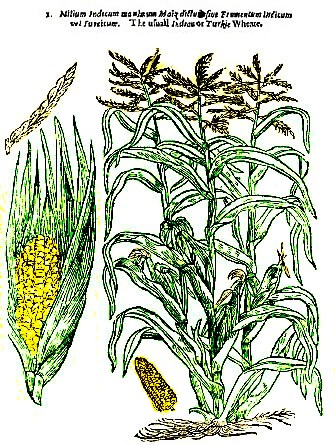
Corn or Turkey Wheat, From Theatrum Botanicum the Theater
of Plants,
By
John Parkinson (1640)
6 of them refer to Guinea corn. Guinea corn is actually not corn at, but a type of sorghum wheat; yet another grain rather than a vegetable. All but 2 of the instances of Guinea corn overlap with instances of Indian corn, leaving 6 instances of an unspecified type of corn in the sailor's accounts. One is found in the General History of the Pyrates where sea surgeon John Atkins simply mentions 'corn' being on São Tomé, Príncipe, and Annobón. However, he later specifically calls it Indian corn, so it is out.3
Several of the other instances can similarly be discounted based on the details of the account. One account refers to corn growing in Wales.4 However, here, corn can be "Any GRAIN such as BARLEY, OATS, RYE, WHEAT, but probably not RICE, nor the so-called INDIAN CORN that only became commercially available towards the end of this period [early 1800s] in Britain."5 So that is also out.
While somewhere near Panama in 1685, French buccaneer Ravaneau de Lussan explains that captain Edward Davis' ship "had taken a ship called the St. Rose, laden with corn and wine, bound from Truxillo for Panama"6. Similarly, in April of 1687 buccaneers took the town of Huaquillas, Ecuador where they captured "four hundred sacks of corn", eventually gathering 20 sacks of ‘meal’ (cornmeal) by May 23.7 Privateer George Shelvocke similarly talks about taking 'bushels of' corn from Iquique, Chile in October of 1720.8 Given the method of storage in instances, they were talking about dry (dent) corn.
The only two remaining instances of what might be sweet corn come from Alexander Hamilton's account of his travels in India.9 Although the historical record is unclear, Indian corn was probably brought to India by the Portuguese during the sixteenth century10. This also would have been dent or 'Indian' corn. While it is possible that sweet corn might have developed there just as it did in North America, it would have had to have been recognized as edible while fresh and actually eaten, something for which no proof exists for this period.
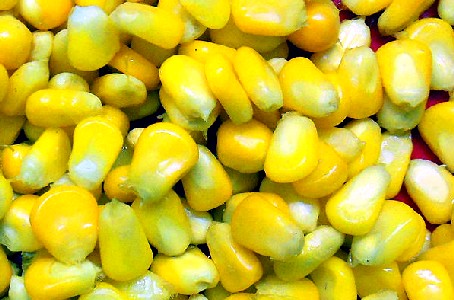
Photo: wiki user HitroMilanese - Sweet Corn Kernals
Dent/flint corn was called Indias or Indian 'panick' by the botanists of the period, often cited under an entry for Turkey or Turkish Wheat.11 As the name suggests, it was regarded by all of them as a type of grain or wheat. French botanist Louis Lémery explains in his entry on bread, "There grows in several parts of Africa, Asia and America, a kind of Corn called Mays, and such as we commonly name Turkey-wheat."12 While in Jamaica around the golden age of piracy, both mathematician and chemist John Taylor and physician Hans Sloane both refer to the plant as maize or corn, which they identify as a grain.13
There are two period examples of corn being used in a manner which sounds like it might refer to sweet corn. One comes from physician William Salmon, who talks about 'Parched Corn'. "This whether it be of the dryed Corn, or before it is ripe, is much eaten by the Indians, because of the easie Preparation, and its exceeding Gratefulness of the Palate."14 Dry corn is obvious dent/flint corn. It is not clear how parching this might make it more edible.
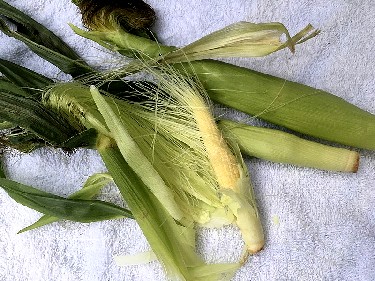
Photo: Wiki user Nesnad - Baby Corn Still in Husks
Using the corn 'before it is ripe' has the greater possibility of being some form of sweet corn. The second example comes from fellow physician Hans Sloane. He explains that in Jamaica, "Indian Corn or Maiz, either tosted or boil'd, is fed on by the Slaves, especially the young Ears of it, before ripe, are rosted under the Coals and eaten; this is thought by them very delicious"15. This sounds much more like the way sweet corn is sometimes prepared. Note that he doesn't bother to suggest preparing dent/flint corn in this manner, although he does refer to it as maize. However, Atkins, something of a snob when it comes to food, dismisses it as food for slaves, just as Salmon dismissed it as food for 'Indians'. It is possible to eat dent/flint corn before it is ripe, although it may refer to what is now called baby corn, often put in salads, which picked when the cob is very immature.16
Because the period experts and sailor's accounts either directly or indirectly refer to corn as dry or dent corn and considering the impossibility of determining if any of the non-specific sailor's accounts were talking about sweet corn, it is nearly impossible that sweet corn is found in any of these accounts. However, it is included here to explain the difference between corn as a grain and corn as a vegetable and to admit the (very slight) possibility that it may have been used as such during this time..
1 Jonathan R. Schultheis, "SWEET CORN PRODUCTION", Leaflet Number 13, Published by the North Carolina Cooperative Extension Service, 1994, p. 1; 2 Paula Marcoux, "Sweet Corn, Bitter History", ediblesema.com, gathered 11/4/22; 3 Daniel Defoe (Capt. Charles Johnson), A General History of the Pyrates, Manuel Schonhorn, ed., 1999, p. 179 & 183; 4 Edward Barlow, Barlow's Journal of his Life at Sea in King's Ships, East and West Indiamen & Other Merchantman From 1659 to 1703, p. 74, 5 "Corn", Dictionary of Traded Goods and Commodities, 1520-1820, british-history.ac.uk, gathered 11/3/22; 6 Ravaneau de Lussan, The History of the Buccaneers of America, 1856, p. 336; 7 de Lussan, pp. 415 & 421; 8 George Shelvocke, A Voyage Round the World by Way of the Great South Sea, 1726, p. 268; 9 Alexander Hamilton, A New Account of the East Indies, 1746, p. 353; 10 Bhag Singh, Races of Maize in India, 1977, p. 6; 11 See John Gerard, The Herball or General Historie of Plantes, 2nd ed, 1636, p. 84; John Parkinson, Theatrum Botanicum the Theater of Plants, 1640, p. 1138; Louis Lémery, A treatise of foods in general, 1704, p. 71; Georgius Everhardus Rumphius, The Ambonese Herbal, E. M. Beekman, Ed, Vol. 4, 2011, p. 115; 12 Lémery, p. 71; 13 John Taylor, Jamaica in 1687, David Buisseret ed, 2010, p. 221 & Hans Sloane, A Voyage to the Islands Madera, Barbados, Nieves, St Christophers and Jamaica, Vol. 1, 1707, p. 105; 14 William Salmon, Botanologia - The English Herbal, 1710, Book 2, p. 1254; 15 Hans Sloane, A Voyage to the Islands Madera, Barbados, Nieves, St Christophers and Jamaica, Vol. 1, 1707, p. xix; 16 See "Baby Corn", wikipedia.com, gathered 2/15/23
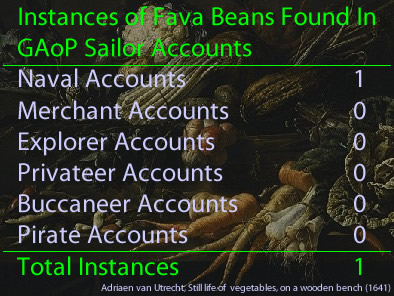
Fava Bean
(Vicia faba)
Called by Sailors: Horse Beans
Vegetable Type: Legume
Appearance: 1 Time, in 1 Unique Ship Journey from 1 Sailor Account.1
Locations Found in Sailor's Accounts: Alicante, Spain
The term fava bean does not actually appear in any of the sailor's accounts, although it is likely they were provided as food to sailors, particularly in the East Indies and Mediterranean. This requires further explanation.
As discussed in the entry on beans, it is sometimes impossible to be certain what type of bean a sailor may have been talking about when they did not specifically mention the type. The term 'calavance' is usually thought to refer to hyacinth beans, but it could also refer to other Old World beans such as fava beans or garbanzo beans (chickpeas). There are 7 instances of calavances in the sailors accounts under study and any of them could have been fava beans. Because it is impossible to be certain what they were, they are not counted here, instead being included under beans.
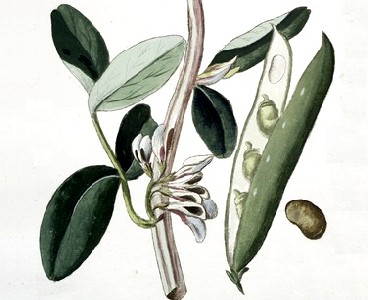
Fava Grossa, Fava Bean, Pod, Flower an Plant, From Hortus
Romanus,
By Nicolao Martello (1772)
There is a single entry which probably refers to fava beans, however. It comes from HMS St. David, when stopped in Alicante, Spain in August of 1670. Naval clerk John Baltharpe reported that "[a] kind of Horse-beans" were substituted on the vessel for peas.2 (It was standard naval practice to purchase local foods for use at sea when abroad, particularly in the Mediterranean.) 'Horse bean' is a dismissive term; as one modern author explains, it was used because "fava beans [are] one of the premier fodder crops
for horses"3. So Baltharpe's use of the term is actually a complaint about being fed food he feels is meant for cattle.
Fava beans are a type of vetch found in European, East Asian, Latin American and North African countries. Two of the period botanists under study call them by the name vetch or tare. Because they originally came from the Mediterranean Basin and Central Asia, they are considered an "Old World" vegetable, "being among the most ancient plants in cultivation and also among the easiest to grow."4
Botanist John Parkinson identifies six different types of vetches, only two of which he says are used in any way as food. The first he calls 'manured Vetch or Tare', explaining that they "are long and somewhat broad, wherein lye five or six flat blackish seede and in some grayish". The second is the 'white manured Vetch' which he simply says is like the first, but 'more white.'5 Fellow botanist John Gerard similarly explains that vetches "the cods be broad, small,
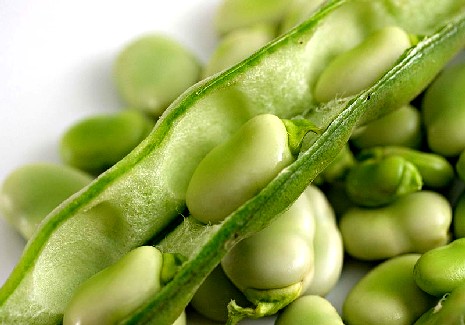
Photo: H. Alexander Talbot - Fava Beans in Pod
and in every one are contained five or six graines, not round, but flat like those of the Lentill, of colour blacke"6.
Neither of them think much of them as food. Just as Baltharpe dismissed them as 'horse beans', Parkinson notes that they "are sowen in fields as Beanes and Pease to serve for cattells foode... whereof in necessitie the poore are forced to make their bread"7. Gerard simply says that they have "an unpleasant taste."8 From this statement it is possible that he is talking about bitter vetches (Vicia ervilia). These can be eaten if prepared properly, although they "have really only been consciously cultivated as animal fodder."9 Quoting Galen, Parkinson says that vetches "yeeld a thicke clammy nourishment".10
Nothing is mentioned in these botanists' books about the humoral properties of vetches. Gerard notes that they bind the stomach indicating that they would "ingendreth a thick bloud [one of the bodily humors],and [people who eat them would be] apt to become melancholy [a humoral temperament caused by an excess of the humor black bile]."11 Medicinally, Parkinson says they "are hard of digestion, and bind the belly... the meale thereof is used with other things to stay running Ulcers and Cankers that are ready to Gangrene: and [can be] made into a Pultis [pultice] and layd on the belly they binde a laske [looseness of the bowels]."12
1,2 John Baltharpe, The straights voyage or St David's Poem, 1671, p. 54; 3 Ken Albala, Beans - A History. 2007, p. 67; 4 "Vicia faba", wikipedia.com, gathered 10/4/22; 5 John Parkinson, Theatrum Botanicum the Theater of Plants, 1640, p. 1072; 5 John Gerard, The Herball or General Historie of Plantes, 2nd ed, 1636, p. 1126; 7 Parkinson, p. 1073; 8 Gerard, p. 1126; 9 Albala, p. 91; 10,11 Gerard, p. 1126; 12 Parkinson, p. 1073
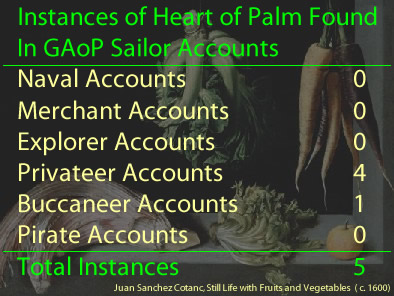
Heart of Palm
(Bactris gasipaes, Cocos nucifera, Euterpe edulis, Euterpe oleracea, Juania australis, Sabal genus)
Called by Sailors: Cabbage, Cabbage-Fruit, Palm-Cabbage
Vegetable Type: Salading
Appearance: 5 Times, in 3 Unique Ship Journeys from 3 Sailor Accounts.1
Locations Found in Sailor's Accounts: Mindanao, Philippines; St. Catherine's Island, Brazil; Juan Fernandez Island, Chile; Manta, Ecuador;
What we today call heart of palm is harvested from the tops of a variety of palm trees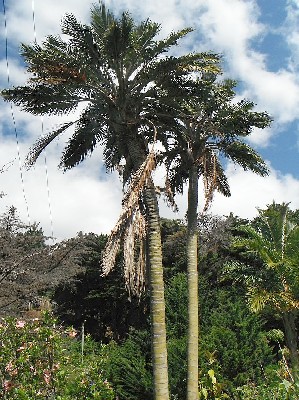
Photo: Ashley Basil
Juania australis, Heart of Palm Tree on Robinson Crusoe Island
. The sailors during this period typically call it a type of cabbage. Privateer Edward Cooke gave a pretty good description when he encountered them on Juan Fernandez Island in February of 1709 during his journey around the world with Woodes Rogers. "This Island produces a Sort of Cabbage-Tree, which is in the Nature of a Palm, the Cabbage [heart of palm] small, but very sweet. The Tree is slender, and strait, with Knots about four Inches above one another, and no Leaves, except at the Top. ...The Cabbage, when cut out from the Bottom of the Branches, is about a Foot long, and very white"2. Since Cooke was on Juan Fernandez, he was likely describing the Juania australis tree.
Dampier describes heart of palm he found in Ecuador as being "in the midst of these Branches, from the top of the Tree; it is invested with many young Leaves or branches which are ready to spread abroad, as the old Branches drop and fall down. The Cabbage it self, when it is taken out of the Leaves which it seems to be folded in, is as big as the small of a Man’s Leg"3. Dampier was likely talking about the Bactris gasipaes plant which is cultivated in Ecuador for its heart of palm. Priest and sometime sailor Jean-Baptiste Labat observed while on Martinique in 1694 that "the heart of the tree, or to put it better, leaves which are not yet hatched, [are] folded like a fan, and tight against each other, white, tender, [and] delicate"4.
Regarding flavor of heart of palm physician Hans Sloane says heart of palm is as "sweet as a Nut when eaten raw"5. Father Labat suggests it is "of a taste approaching that of artichoke hearts."6 Dampier notes it "is very sweet and wholsome if boiled."7
Fellow buccaneer and surgeon William Hughes agrees with preparing them by boiling, adding "it is a very good Aliment [food], eaten with Butter and Vinegar"8. Physician Hans Sloane, talking about those he found in the Caribbean says "when boil'd with Beef are as good as Cabbage"9. Labat, ever the gourmet, provides a variety of ideas for their preparation:
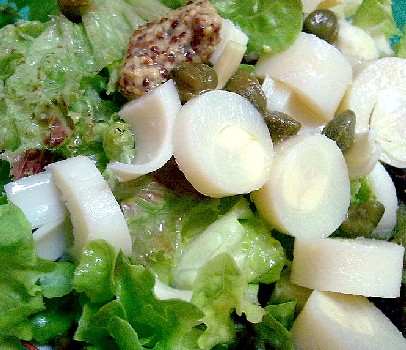
Photo: Flickr User Lablasco - Heart of Palm in a Mustard Salad
We put them in fresh water, and we eat them with pepper and salt like young artichokes, or else we boil them in water with salt; and after they are drained, they are put in a white sauce like Spanish cardoons [Cynara cardunculus] or cercisis with nutmeg. They are still prepared like donuts by dipping them in a fine paste, and putting them in the pan, with oil or butter; or else they are fried like fish, after coating them with flour. We put them in the soup, giving them a very good taste; finally we eat them in a salad after we have developed all the leaves: however we use them, they are very good and very delicate10
Little is said about heart of palm from a humoral standpoint. William Hughes does mention that they "very well agree with our hot stomacks, while we are in health, being eaten moderately"11. This could suggest they are cooling, although Hughes' grasp of medicine seems less clinical than most of the other botanists and physicians under study here. By comparison, the more clinical Sloane doesn't even venture a guess about their humoral properties, probably because they aren't found in any of the classical medical texts.
In regard to health, Father Labat mentions that "it is a light food and easy to digest"12. However, Hughes says heart of palm is "windy, apt to oppress the stomack, offend the head, especially in those who have lived along time there, by reason of the weakness and decay of natural heat."
1 Edward Cooke, A Voyage to the South Sea and Round the World, Vol. 1, 1712, p. 116; William Dampier, A New Voyage Round the World,1699, p. 166; George Shelvocke, A Voyage Round the World by Way of the Great South Sea, 1726, p. 54, 228, 249; ; 11 See John Gerard, The Herball or General Historie of Plantes, 2nd ed, 1636, p. 84; John Parkinson, Theatrum Botanicum the Theater of Plants, 1640, p. 1138; Louis Lémery, A treatise of foods in general, 1704, p. 71; Georgius Everhardus Rumphius, The Ambonese Herbal, E. M. Beekman, Ed, Vol. 4, 2011, p. 115; 2 Cooke, p. 116-7; 3 Dampier, p. 166; 4 Jean Baptiste Labat, Nouveau Voyage aux Isles de l'Amerique, Tome 1, Translated by the author, 1724, p. 422; 5 Hans Sloane, A Voyage to the Islands Madera, Barbados, Nieves, St Christophers and Jamaica, Vol. 2, 1707, p. 117; 6 Labat, p. 422; 8 Dampier, p. 166; 9 William Hughes, The American physitian, 1672, p. 80; 10 Labat, p. 422-3;
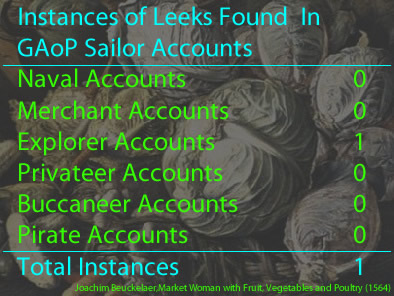
Leeks
(Allium ampeloprasum)
Called by Sailors: Leek
Vegetable Type: Salading
Appearance: 1 Time, in 1 Unique Ship Journey from 1 Sailor Account.1
Locations Found in Sailor's Accounts: Salvador, Brazil;
Buccaneer William Dampier found leeks along with "abundance of other Salading... for the Pot"2 when his exploratory vessel Roebuck stopped in Brazil on the way to Australia in 1699. Dampier says nothing more about them, probably because leeks were very familiar to English sailors, having been brought there by the Romans when they occupied Britain.
Because they are so familiar, several botanists from around this period comment on leeks, although even they are somewhat terse in their descriptions. John Parkinson explains, "Leekes are very like unto Onions, having long green hollow-like leaves, flattish on the one side, and with a

ridge or creft on the backe side: ...in the second or third yeare after the sowing, they will send forth a round and slender stalke, even quite throughout, and not swollen or bigger in the middle like the
Onion"3. However, the edible part of the leek is only "erroneously called a stem or stalk, the bundle of leaf sheaths, and the lighter green parts, are the edible parts of the plant. The dark green parts are usually discarded as they have a tougher texture."4
French botanist Louis Lémery explains that people "carefully sow Leeks in Kitchin-Gardens"5, suggesting their use as food in France. John Gerard notes that leeks are "in smell and taste like to the Onion."6 However, Parkinson dismisses them as common food, commenting that while people in the past "fed much upon Leekes, Onions, and Garlicke boyled with flesh... which ...our dainty age now refuseth wholly, [by] all sorts [of people] except the poorest."7 He does admit that they are used during Lent (a time of fasting) to make pottage (a thick stew) as well as being eaten in Wales 'by vulgar Gentlemen.'
Humorally, Gerard says, "The Leeke is hot and dry; and doth attenuate or make thinne [bodily humors] as doth the Onion." He recommends combining leeks "with cold herbes [so that] his too hot quality is tempered." He also considers boiling them to reduce the 'sharpness' of the humors, but worries that "being so used it yeeldeth no good juyce."8 Adopting the Paracelsian principals instead of the humoral view, Lémery says that leeks "contain much Oil and essential Salt."9
Medicinally, Parkinson says "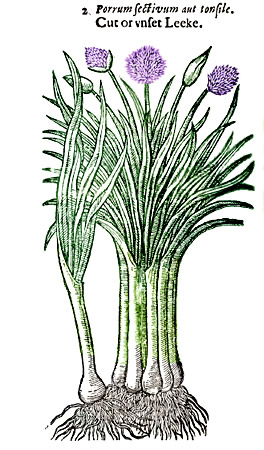
'Cut or Unset Leek', From The
Herball or General
Historie of Plantes, By John Gerard (1636)
Leekes are held [thought] to free the chest and lungs from much corruption and rotten flegme [phlegm, one of the body's humors], that sticketh fast therein, and [is] hard to be avoided, as also for them that through hoarsenesse have lost their voice, if they be eyther taken rawe, or boyled with broth of barley, or some such other supping, fit and conducing thereunto."10 It is interesting that the man who dismissed leeks as food for the poor and vulgar gives recipes for its' use as a medicine. He adds, "The greene blades of Leekes being boyled and applyed warme to the Hemorrhoides or piles, when they are swolne and painfull, give a great deale of ease."11 Gerard recommends boiling them with ptisans [a drink made of sweetened barley-water] or barly creme to "concocteth and bringeth up raw humors that lie in the chest." He adds "The juyce drunke with hony is profitable against the biting of venomous beasts; and likewise
the leaves starnped and laid thereupon.
The same juice, with vinegre, frankincense and milke, or oyle of roses, dropped into the eares, mitigateth their paine, and is good for the noyse in them."12 In his book on salads, John Evelyn suggests that leeks "are also friendly to the Lungs and Stomach, being sod in Milk; a few therefore of the slender and green Summities [tops], [being] a little shred[ed], do not [go] amiss in Composition."13 Lémery says a leek "excites Urine, Women's Terms, and humane Seed, by its sharp, incisive and penetrating Salts: Being applied externally, it helps Suppuration [formation of pus]; because it digests, ripens, and attenuates the matter to be Suppurated, and imparts Strength and Motion enough to it to make its way out"14. Pus was encouraged in wounds because it was believed to be tainted humors being ejected from the body, allowing a wound to heal.
In an unusual turn, Gerard includes a section called 'The Hurts' listing problems that consumption of leeks cause. "It heateth the body, ingendreth naughty bloud [a bodily humor],causeth troublesome and terrible dreames; offendeth the eies, dulleth the sight, hurteth those that are by nature hot and cholericke [referring to the temperaments which are based on the bodily humors], and is noysome to the stomacke, and breedeth windinesse."15 Lémery notes that some authors "make it to be a very pernicious Food; yet we do not find, though much used amongst us, that it produces all those ill Effects that are attributed to it: Indeed, 'tis somewhat hard of Digestion, and sometimes causes Wind, by reason of the viscous and glewy Phlegm contained therein; and therefore it ought always to be well boiled before it is eaten, to the end this ill Juice may be attenuated thereby."16
1,2 William Dampier, A New Voyage Round the World, Vol III, 1703, p. 72; 3 John Parkinson, Paradisi in Sole, Paradisus Terrestris, Reprinted from the Edition of 1629, 1904, p. 512; 5 Mark & Jill Hatch, "A Brief History of Foods: Leeks", www.tastesofhistory.co.uk, gathered 11/9/22; 5 Louis Lémery, A treatise of foods in general, 1704, p. 90; 6 John Gerard, The Herball or General Historie of Plantes, 2nd ed, 1636, p. 175; 7 Parkinson, p.. 513; 8 Gerard, p. 175; 9 Lémery, p. 89; 10,11 Parkinson, p.. 513; 12 Gerard, p. 175; 13 John Evelyn, Acetaria, or a Discourse of Sallets, 1699, p. 90; 14 Lémery, p. 90; 15 Gerard, p. 175; 16 Lémery, p. 90
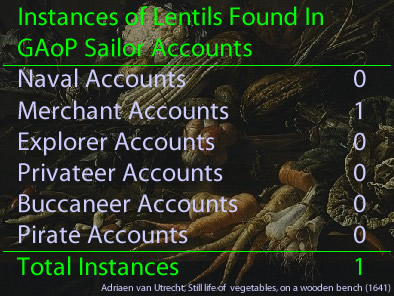
Lentils
(Lens culinaris or Lens esculenta)
Called by Sailors: Lentil
Vegetable Type: Legume
Appearance: 1 Time, in 1 Unique Ship Journey from 1 Sailor Account.1
Locations Found in Sailor's Accounts: Not Stated in Account
Lentils were originally cultivated in the Fertile Crescent which today includes eastern Turkey, northern Iraq and Syria. "The earliest charred remains of wild lentils, an indication of cooking, date from about 11000 BCE and are found at the Franchthi Cave in Greece."2 The plants spread throughout the Middle East, Europe and northern Africa from there. They were almost certainly substituted for peas or other legumes on some English ships traveling in the Mediterranean or East Indies, although only one sailor's account under study mentions them.
Surgeon Johann Dietz was serving as the master on the Dutch whaling vessel Hope of Rotterdam sailing in the North Sea. He explains that "at least three days of the week we ate groats [a type of grain like oats, wheat, barley or millet] pease, lentils and stock fish [unsalted fish dried on racks in cold air], boiled, and pickled beef, pork and mutton, with bacon and a great
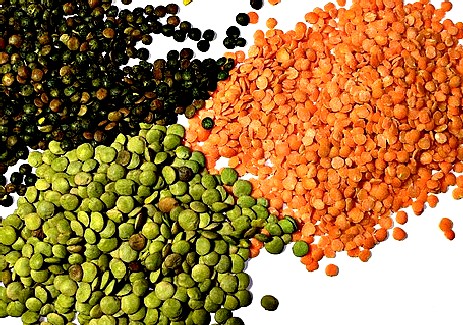
Photo: Justin Cormack - Three Types of Dried Lentils
deal of butter."3 This actually has a lot more variety than a normal sailor's diet. Dietz was serving as a master, so this list may actually reflect the officer's food and not the standard rations of before-mast sailors. It may also have been the diet on this Dutch whaler, although it seems unusual to have regular sailors served more than one kind of meat on a ship. Since Dietz doesn't specify if was officer or regular food in his account, it is impossible to be sure.
Writing in 1640, botanist John Parkinson identified three different kinds of lentils: the greater lentil, the lesser lentil and the spotted lentil. He says the greater lentils produce "small short, and somewhat flat cods, within which are contained two or three flat round smooth seede[s], of a pale yellowish ash colour". The lesser lentils are mostly the same, but are 'whiter'. The spotted lentil "is blackish, spotted with blacker spots."4 Botanist John Gerard only identified two types of lentil, the first being like Parkinson's greater lentil and the second having "flat cods, containing little browne flat seed[s], and sometimes white."5
As food, Parkinson says that the lesser lentil is "the more pleasant and acceptable" of the lentils, noting that people in the country use it as animal food.6 Gerard says they grow in his garden, but similarly says they are used as animal food. He does provide a number of recipes for them as medicines, but doesn't offer any suggestions for using them as food.7 French botanist Louis Lémery says, "Lentils afford indifferent
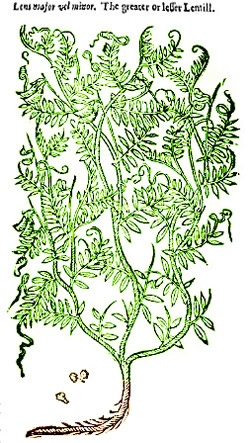
Lentil Plant, From The
Herball or General
Historie of Plantes, By John Gerard (1636)
Nourishment" and notes that the are eaten during Lent and says the they were thought by the ancients to be "soft to the taste."8 Those Dietz mentioned would have been dried and then boiled on the ship's stove before serving like peas.
Galen talked about lentils, so both Gerard and Parkinson cite his comments in regard to the humoral qualities of lentils. Gerard explains that they are "in a meane betweene hot and cold, yet are they dry in the second degree"9. Lémery gives the Paracelsian principles found in lentils. "They contain an indifferent quantity of essential Salt, and much Oil and Earth." Talking about humoral temperaments, he adds, "Lentils agree at all times, and at any Age, with Persons of a hot and cholerick Nature, phlegmatick Constitution [having an excess of wet and cold humors]; but those who are Melancholy [an excess of cold and dry humors], and abound with earthy and gross Humours, ought to abstain from them."10
Medicinally, Gerard says that lentil "skin is astringent or binding, and the meate or substance within is of a thicke and earthy juyce, having a quality that is a little austere or something harsh, much more [so than] the skin thereof: but the juyce of them is quite contrary to the binding quality"11. As a result, when physicians who want to use lentils to bind the stomach he explains that they should boil them and "cast away the first water, and [boil them again and] use the second [water], which staieth laskes [diarrheas] and strengthen the stomach and all the inward parts."12 When a physician actually wanted to loosen the stomach, Gerard points out that the first water would be used.
Suggestions were made for combining lentils with a variety of other things to supplement their qualities. Gerard says "Lentils mixed with hony doth mundifie [cleanse] and clense corrupt ulcers and rotten sores, filling them with flesh againe; and is most singular to be put into the common digestives [medicines that promote the growth of healthy flesh] used among our London Surgeons for greene [new] wounds."13 Honey was believed to having cleansing properties. Combined with the drying properties of lentils, it would seem to be ideal for healing.
Parkinson warns that, according to Galen, lentils soup "breedeth Leprosie and cankers"14. More in line with their suggested properties, Gerard warns that they create "thicke bloud, and such as slowly passeth through the veines." He also says they "hurteth the head, sinewes and lungs", citing Dioscorides.15
1 Johann Dietz, Master Johann Dietz, Surgeon in the Army of the Great Elector and Barber to the Royal Court, 1923, p. 152; 2 Ken Albala, Beans - A History. 2007, p. 9; 4 Dietz, p. 152; 4 John Parkinson, Theatrum Botanicum the Theater of Plants, 1640, p. 1067; 5 John Gerard, The Herball or General Historie of Plantes, 2nd ed, 1636, p. 1223; 6 Parkinson, p. 1068; 7 Gerard, pp. 1224-5; 8 Louis Lémery, A treatise of foods in general, 1704, p. 71; 9 Gerard, p. 1224; 10 Lémery, p. 62; 11 Gerard, p. 1224; 12 Parkinson, p. 1068; 13 Gerard, p. 1224; 14 Parkinson, p. 1068; 13 Gerard, p. 1225
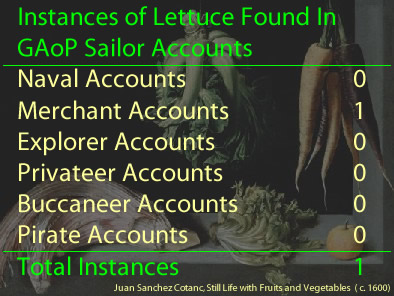
Lettuce
(Lens culinaris or Lens esculenta)
Called by Sailors: Lettice
Vegetable Type: Salading
Appearance: 1 Time, in 1 Unique Ship Journey from 1 Sailor Account.1
Locations Found in Sailor's Accounts: Cape Coast Castle, Africa;
Lettuce appears in a single account, being included with "all sorts of Greens, as Cabbages and Lettices of several sorts, and other Esculents"2. It almost certainly included as one of the vegetables in the generic mentions of salading in the sailor's accounts, but without further detail, these cannot be included among the definite instances..
Garden lettuce was likely cultivated by the Egyptians who selected the mildest seeds from a variety of closely-related, bitter-tasting wild species found in the Mediterranean Basin and south west Asia.3 These would have been Romaine-like "upright lettuces [which] were developed by the Egyptians and passed to the Greeks, who in turn shared them with the Romans."4
By the seventeenth
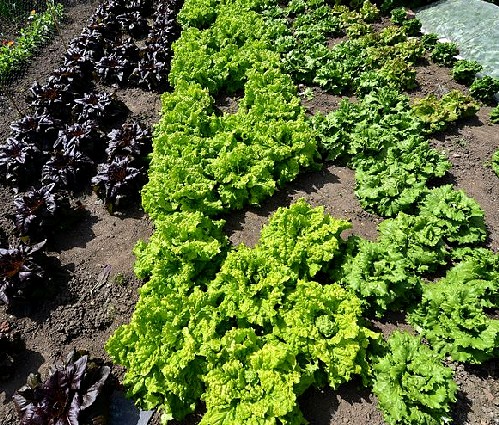
Photo: Michael Garlick - Different Types of 'Loose' Cultivated Lettuces
century botanist John Parkinson declared, "there are so many sorts, and so great diversitie of Lettice, that I doubt I shall scarce be beleeved of a great many. For I doe in this Chapter reckon up into you eleaven or twelve differing sorts; some of little use, others of more, being more common and vulgar; and some that are of excellent use and service"5. French botanist Louis Lémery says, "There are two sorts of Lettices; the one they
call the wild Lettice, and is used only in Physick [medicine]; the other is Garden Lettice, which last is subdivided into several other Species, that
are commonly used. for Seed; as the Headed Lettice, and that contrary to it; the Roman-Lettice... and the curled or crisp Lettice."6
True to his word, Parkinson lists eleven types of lettuce in his book. Among these are four with familiar names. These include red and white 'Romane' lettuces, the red being "the best and greatest of all the rest" and white "like unto it [the red], having long leaves like a Teasell [teasel - genus Dipsacus] it is in goodnesse next unto the red, but must be whited, that it may eate kindly"6.
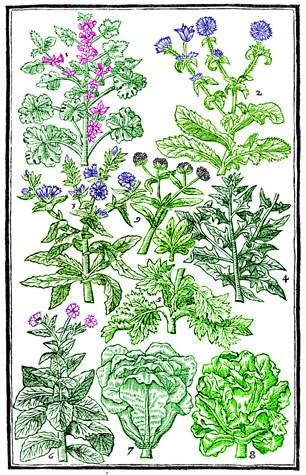
Types of Lettuce, From The
Herball or General
Historie of Plantes, By John Gerard (1636)
1. Malba crispa. French Mallowes. 2. Endivia. Endive. 3. Chicorum.
Succory.
4. Spinachia. Spinach. 5. Lactuca crispa. Curld Lettice.
6. Lactuca patula. [probably Lactuca Tartarica] An open Lettice.
7. Lactuca capitata. vulgaris. Ordinary cabbage Lettice. [Iceberg]
8. Lactuca capitata Romana. The great Romane cabbage Lettice.
9. Lactuca aguino. Corne sallet or Lambes Lettice.
'Whited' refers to making the lettuce lighter colored. Parkinson says this can be done "by raysing up earth like moale hils, round about the plants while they
are growing, which will make them grow white" or "by tying up all the loose
leaves round together while it groweth, that so the close tying may make it grow
white, and thereby be the more tender."7 He mentions a second, dark green Romaine lettuce which he suggest is 'an excellent kinde'. The third familiar lettice he calls 'common Cabbage Lettice'. 'Cabbage' here means that the head closes and forms a ball like cabbages do. This most likely refers to what we call iceberg lettice, which he notes is well known. The fourth familiar lettuce is lamb's lettuce or cornsalad (Valerianella locusta). He says it has "many whitish greene, long and narrow, round pointed leaves... with small round stalkes, with two leaves at every
joynt, branching forth at the toppe, and bearing tufts of small bleake blew flowers". Parkinson elsewhere states that he doesn't consider lamb's lettuce to be a type of lettuce at all, noting that the flavor "is of a waterish taste, almost insipide."8
In addition, Parkinson includes several lettuces whose modern names are different than those used during this time, making them a little more difficult to identify. He mentions one type that 'doth cabbage' (form a solid core) with curly leaves "called Flanders Cropers, or Cropers of Bruges; this groweth lowest, and hath the smallest head, but very hard and round, and white while it groweth". This is probably Belgian endive. He discusses another "curld Lettice which is open, and differeth but little from Endive". This may be coral or lollo rosso lettuce. There are two lettuces which reference locations: the Virginia ("single and very broade reddish leaves, and is not of any great regard") and Venice ("an excellent Cabbage (solid round core) Lettice, and is best to bee sowen after Midsummer for lateward Lettice; they be sometimes as great as the crowne of a mans hatt"). What these are called today is uncertain from the text, but the Virginia Lettuce is likely one of the red leaf lettuces and the Venetian lettuce is probably a radicchio. Parkinson also lists "common Lumbard Lettice that is loose, and another kinde thereof that doth somewhat cabbage"9. Two centuries later, Edward Lewis Sturtevant identified Lombard lettuce as Lactuca intybacea aka. wild lettuce or chicory.10 This does not explain the 'cabbage' type that Parkinson mentions, however. His last lettuce is a winter lettuce which he says is "wonderfull hardy to endure our cold: It is but single, and must be sowen at Michaelmas (Sept. 29th), but will be very good, before any of the other good sorts sowen in the Spring"11. A variety of lettuces will grow during the English winter, so it is impossible to be sure which lettuce he is talking about.
As food, lettuce is primarily recognized for its role in salads. Author and gardener John Evelyn declared that it "ever was, and still continues the principal Foundation of the universal Tribe of Sallets"12. Botanist John Gerard also says "maketh a pleasant sallad, being eaten raw with vineger, oile, and a little salt"13. Parkinson similarly notes that garden lettuces "are spent in sallets, with oyle and vinegar, or as every one please, for the most part, while they are fresh and greene, or whited, as is declared of some of the sorts before, to cause them to eate the more delicate and tender."14 Lémery notes that it "is
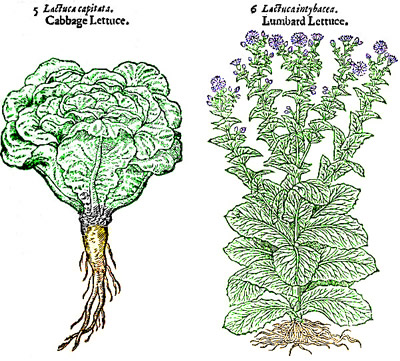
Iceberg (Cabbage) Lettuce and Chicory (Lombard Lettuce), From
The Herball or
General
Historie of Plantes,
By
John Gerard (1636)
a Plant much used, because of the good effects produced by it", further recommending choosing "all your Lettice when they are tender, young, full of Juice, and such as grow in Gardens in a fat soil."15
Gerard adds an interesting observation about serving raw lettuces in salad.
It is served in these daies, and in these countries in the beginning of supper, and eaten first before any other meat: which also Martiall [Marcus Valerius Martialis, 1st century AD roman poet] testifieth to be done in his time, marvelling why some did use it for a service at the end of supper, in these verses.
...
Tell me why Lettuce, which our Grandsires last did eate,
Is now of late become, to be the first of meat [food]?16
He admits that "being taken before meat [food] it doth many times stir up appetite", perhaps as a way to explain this preference. Lettuce was also cooked and served with the main course. Parkinson explains that lettuces "are also boyled, to serve for many sorts of dishes of meate [food], as the Cookes know best."17 Gerard opined that if lettuce is to "be boiled it is sooner digested, and nourisheth more."18
Humorally, Gerard explains that "Lettuce is a cold and moist pot-herbe, yet not in the extream degree of cold or moisture, but altogether moderately, for otherwise it were
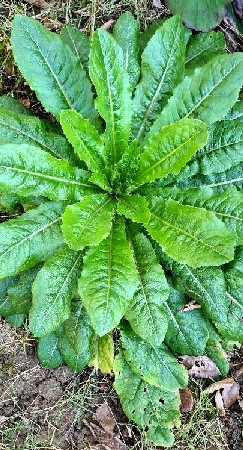
Photo: Nathalie Bertrix
Wild Lettuce (Latuca virosa, Bitter but Medicinal
not to be eaten."19 Evelyn cites Galen as saying that lettuce had a pinguid [oily], subdulcid [sweet] and agreeable Nature... it breeds the most laudable Blood [one of the four bodily humors]."20 He also says that lettuce allays heat and restrains choler, another bodily humor. Lémery provides the Paracelsian perspective, listing lettuce's principles as "much essential Salt, and Phlegm, an indifferent quantity of Oil; and a little Earth." Interestingly, he adds that lettuce "cools and moistens much, by calming an qualifying the motion of the humours by its milky and viscous Phlegm."21 So it basically works the same way as Galen said in the Paracelsian regime.
Medicinally, Evelyn proclaims, "we meet with nothing among all our crude Materials and Sallet store, so proper to mingle with any of the rest, nor so wholsome to be eaten alone, or in Composition"22. He cites several examples of authors from antiquity praising lettuce, noting that it is "so harmless that it may safely be eaten raw in Fevers; for it ... extinguishes Thirst, excites Appetite, kindly Nourishes, and above all represses Vapours, conciliates Sleep, mitigates Pain, besides the effect it has upon the Morals, Temperance and Chastity."23 Gerard says its cooling properties help with 'the heart-burning' and goes on to recite many of the same health properties attributed to it by Evelyn. He adds, "Lettuce being outwardly applied mitigateth all inflammations; it is good for burnings and scaldings, if it be laid thereon with salt before the blisters do appeare"24. Combined with rose oil, Parkinson recommends it to help people to sleep and "and taketh away paines in the head... If a little camphire be added, it restraineth immoderate lust: but it is hurtfull to such as are troubled with the shortnesse of breath."25 Lemery repeats medicinal uses already mentioned, but also says, "Lettice-Seed is one of the four Cold Seeds in the lesser Degree, and has the same vertue as the Plant it self."26 Indeed, it, along with rose oil and camphor, were carried by some of the sea surgeons on ships.
1,2 Nathaniel Uring, The Voyages and Travels of Captain Nathaniel Uring, 1928, p. 106; 3 "Lettuce", wikipedia.org, gathered 11/28/22 & "Oxford Plants 400: Plant 193", herbaria.plants.ox.ac.uk, gathered 11/28/22; 4 "Lettuce", gathered 11/28/22; 5 John Parkinson, Paradisi in Sole, Paradisus Terrestris, Reprinted from the Edition of 1629, 1904, p. 498; 6 Louis Lémery, A treatise of foods in general, 1704, p. 77-8; 7 Parkinson, p. 498; 8,9 Parkinson, p. 499; 10 Parkinson, p. 498; 11 E. Lewis Sturtevant, "History of Garden Vegetables", The American Naturalist, Volume 22, Sept. 1888, p. 985; 12 John Evelyn, Acetaria, or a Discourse of Sallets, 1699, p. 31; 13 John Gerard, The Herball or General Historie of Plantes, 2nd ed, 1636, p. 308; 14 Parkinson, p. 499; 15 Lémery, p. 78; 16 Gerard, p. 308; 17 Parkinson, p. 499; 18,19 Gerard, p. 308; 20 Evelyn, pp. 31-2; 21 Lémery, p. 78; 22 Evelyn, p. 32; 23 Evelyn, p. 31; 24 Gerard, p. 308; 25 Parkinson, p. 499; 26 Lémery, p. 78
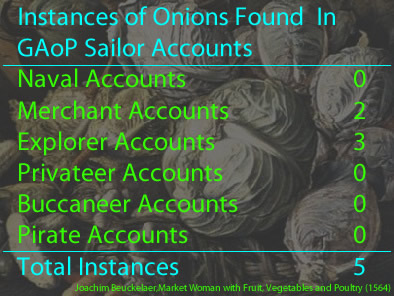
Onion
(Allium cepa)
Called by Sailors: Onion
Vegetable Type: Root
Appearance: 5 Times, in 4 Unique Ship Journeys from 3 Sailor Accounts.1
Locations Found in Sailor's Accounts: Tenerife, Canary Islands; Greater Tunb, Iran; Haiphong, Vietnam; Salvador, Brazil; Puerto San Julián, Argentina;
Onions were familiar to sailors and are mentioned in several accounts. Dampier talks about the quality of the onions he found in two locations. He; says that the gardens established at Tonquin (Haiphong, Vietnam) had many 'pleasant and wholsome' onions2 and those he found in Tenerife in the Canary Islands were 'the best in the World'3. Beyond that, the sailors have little to say about onions.
Fortunately, the botanists have much to say about them. John Gerard begins by noting there are "divers sorts of Onions, which have their syr-names of the place where the grow: some lesser, others greater, and divers long, but no wilde"4. John Parkinson agrees,
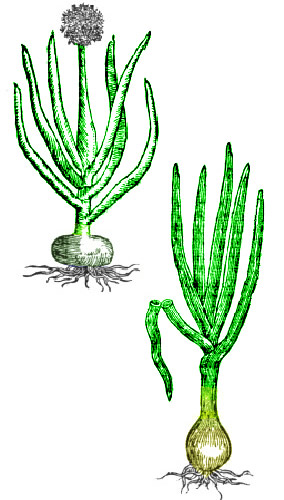
Round Onion (Capae Rotundae) and Long Onion (Cepae
Longae), From Paradisi in Sole Paradisus Terrestris, By
John Parkinson (1629)
proceeding to list and describe six different kinds of onions in his book. (Note that Parkinson appears to mean 'squat' when he calls the onions 'flat', as seen in the image at right which comes from his book.) His six onion types include:
1) Common garden onion - "hath divers long greene hollow leaves, seeming halfe flat; among which among which riseth up a great round hollow stalke, bigger in the middle then any where else... the roote as all know is round, in some greater, in others lesser, or flat, in some red on the outside only, in others quite thorough out, in some white, and very sharpe and strong, in others milder, and more pleasant, and some so pleasant that they may be eaten as an Apple"
2) Red flat onion (Red Baron?) - "most usually with us the strongest of them all, yet I have had a great red Onion brought mee from beyond Sea, that was as great almost as two mens fistes, flat and red quite thoroughout, and very pleasant both to smell unto, and to eate"
3) St. Omer's onion (probably Roscoff) - "long"
4) Strasborough Onions - "whose outside onely is red, and are very sharpe and fierce."
5) White onion - "white... both long and flat, are like unto Chalke-stones lying upon the ground, when they are ripe and fit to be gathered."
6) Spanish onion - "both long and flat, very sweete, and eaten by many like an apple"5
French botanist Louis Lémery says onions are "more or less sharp, according to the place where the same grows. For Example, those Onions which grow in hot Countries are sweet in comparison of ours... It's also to be observed, that oblong Onions are sharper than the round ones, and the red and yellow than the white; the dry than the green, and the raw than those that are boiled."6
Unlike some of the other vegetables, onions seemed to have some esteem among the English botanists. Gerard says the onion
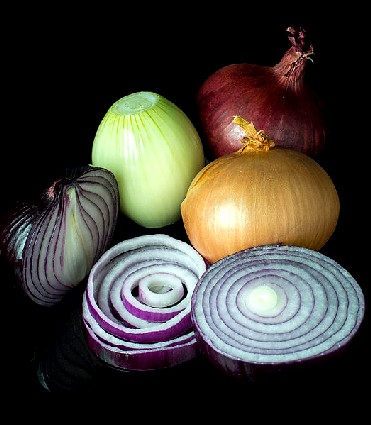
Photo: Wiki User Colin - Red and White Onions
"is cherished everie where in kitchen gardens, now and then sowne alone, and many times mixed with other herbs, as with Lettuce, Parseneps, and Carrets."7 Lémery notes that they are "very well known, a being commonly used." When selecting onions to eat, he advises picking "those that are large, full of Juice, round, as mild as may be, and such as have grown in fat and moist soil."8 English author and gardener John Evelyn recommended choosing "the large, round, white and thin Skin'd."9
A couple of recipes are proposed in the botanists' books. Parkinson, sometimes dismissive of vegetables, explains, "Onions are used many wayes, as sliced and put into pottage, or boyled and peeled and layde in dishes for sallets at supper, or sliced and put into water, for a sawce for mutton or oysters, or into meate roasted being stuffed with Parsly, and so many waies that I cannot recount them, every one pleasing themselves, according to their order, manner or delight."10 Evelyn says they can be eaten "crude and alone with Oyl, Vinegar, and Pepper, we own them in Sallet... Boil'd, they give a kindly relish"11. He later adds that they "are us'd in Pottage, boil'd in Milk, stew'd, &c. ...In our cold Sallet we supply them with the Porrum Sectile [chives], Tops of Leeks, and Eschalots (Ascalonia)... Or ...with a Clove or two of Raccombo [sand leek] ...and an honest laborious Country-man, with good Bread, Salt, and a little Parsley, will make a contented Meal with a roasted Onion."12
Humorally, Galen felt onions were hot and dry in the fourth degree, "but not so extreme hot as Garlicke. The juice is of a thinne waterie and airie substance: the rest is of thicke parts."13 This is not surprising given their 'sharp' flavor, something associated with heat. Lémery give the Paracelsian explanation, indicating that onions contain the principles of "much volatile acid Salt, and an indifferent quantity of Oil."
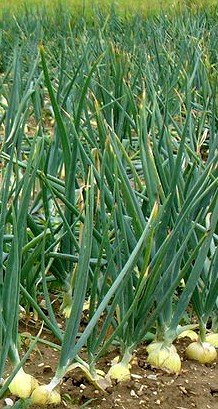
Photo: Rainer Haessner - Field With Onions
He adds that onions are good for people with constitutions which are "Phlegmatick [have an excess of wet and cold humors], and have no
good Digestion; as also with those who do a bound in gross and viscous Humours: But young Persons of an hot and bilious [cold and dry] Constitution ought
to abstain from them, or always use them very
moderately."14
Medicinally, John Evelyn says onions "raise Appetite, corroborate the Stomach, cut Phlegm, and profit the Asthmatical"15. Gerard suggests that they "bite, attenuate or make thin, and cause drynesse: being boiled they do lose their sharpnesse, especially if the water be twice or thrice changed, and yet for all that they doe not Iose their attenuating qualitie."16 Lémery advises, "The Onion is of an opening Nature, dissolves the Stone in the Reins and Bladder, provokes Urine, creates an Appetite, kills the Worms, and is good against the Dropsy, Asthma, and Scurvy: It's also used against Deafness, for resisting of Poison, and to ripen Impostumes. It's used Physically; both internally and externally."17 With external uses in mind, Parkinson comments that their juice is often "applyed to any burnings with fire, or with Gun-pouder, or to any scaldings with water or oyle, and is most familiar for the Country, where upon such sudden occasions they have not a more fit or speedy remedie at hand"18.
Lémery warns that "too frequent use of Onions inflames the Blood, causes Wind and the Head-ach."19 Gerard lists 'Hurts' caused by onions: "being eaten, yea though it be boiled, causeth head-ache, hurteth the eyes, and maketh a man dim sighted, dulleth the sences, ingendreth windinesse, and provoketh overmuch sleep especially being eaten raw."20 (His idea that onions hurt the eyes may be because cutting them releases an enzyme which irritates the glands in the corners of them. Parkinson suggests eating parsley leaves will solve this. It is more likely solved by the tearing of the eye during the time it takes get and eat the parsley leaves.)
1 William Dampier, "Part 1", A Supplement to the Voyage Round the World, 1700, p. 22; William Dampier, A New Voyage Round the World, Vol III, 1703, p. 10 & 72; Alexander Hamilton, A New Account of the East Indies, 1746, p. 88; John Wood, Captain Wood's Voyage Through the Streights of Magellan, &c., A collection of original voyages, William Hacke, p. 73; 2 Dampier, "Part 1", 1700, p. 23; 3 Dampier, 1703, p. 10; 4 John Gerard, The Herball or General Historie of Plantes, 2nd ed, 1636, p. 169; 5 John Parkinson, Paradisi in Sole, Paradisus Terrestris, Reprinted from the Edition of 1629, 1904, p. 512; 6 Louis Lémery, A treatise of foods in general, 1704, p. 112; 7 Gerard, p. 170; 8 Lémery,p. 112; 9 John Evelyn, Acetaria, or a Discourse of Sallets, 1699, p. 47; 10 Parkinson, p. 512; 11 Evelyn, p. 47; 12 Evelyn, p. 48; 13 Gerard, p. 170; 14 Lémery,p. 112; 15 Evelyn, p. 48; 16 Gerard, p. 170; 17 Lémery,p. 112; 18 Parkinson, p. 512; 19 Lémery,p. 112; 20 Gerard, p. 171

